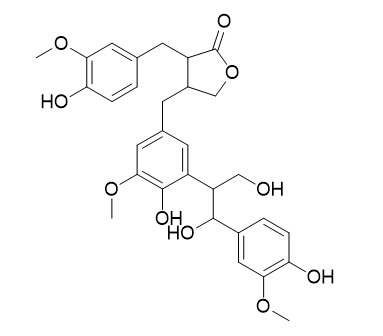Lappaol C
Lappaol C has antioxidant and antiaging properties, it may promote the C. elegans longevity and stress resistance through a JNK-1-DAF-16 cascade. Lappaol C also has potential chemosensitizing activity, it may be candidates for developing novel adjuvant anticancer agents.
Inquire / Order:
manager@chemfaces.com
Technical Inquiries:
service@chemfaces.com
Tel:
+86-27-84237783
Fax:
+86-27-84254680
Address:
1 Building, No. 83, CheCheng Rd., Wuhan Economic and Technological Development Zone, Wuhan, Hubei 430056, PRC
Providing storage is as stated on the product vial and the vial is kept tightly sealed, the product can be stored for up to
24 months(2-8C).
Wherever possible, you should prepare and use solutions on the same day. However, if you need to make up stock solutions in advance, we recommend that you store the solution as aliquots in tightly sealed vials at -20C. Generally, these will be useable for up to two weeks. Before use, and prior to opening the vial we recommend that you allow your product to equilibrate to room temperature for at least 1 hour.
Need more advice on solubility, usage and handling? Please email to: service@chemfaces.com
The packaging of the product may have turned upside down during transportation, resulting in the natural compounds adhering to the neck or cap of the vial. take the vial out of its packaging and gently shake to let the compounds fall to the bottom of the vial. for liquid products, centrifuge at 200-500 RPM to gather the liquid at the bottom of the vial. try to avoid loss or contamination during handling.
Br J Pharmacol.2020, 10.1111
Int J Mol Sci.2020, 21(9):3239.
Front Pharmacol.2022, 13:806869.
Molecules.2020, 25(9):2081.
Geroscience.2024, 01207-y.
Molecules.2022, 27(22):7997.
Molecules.2019, 24(10):E1930
Antioxidants.2022, 11(3):592.
Exp Biol Med (Maywood).2019, 244(16):1463-1474
Nat Prod Commun.2014, 9(5):679-82
Related and Featured Products
Phytochemistry. 2015 Sep;117:340-50.
Natural lignans from Arctium lappa as antiaging agents in Caenorhabditis elegans.[Pubmed:
26141518]
Arctium lappa is a well-known traditional medicinal plant in China (TCM) and Europe that has been used for thousands of years to treat arthritis, baldness or cancer. The plant produces lignans as secondary metabolites, which have a wide range of bioactivities. Yet, their antiaging potential has not been explored.
METHODS AND RESULTS:
In this study, we isolated six lignans from A. lappa seeds, namely arctigenin, matairesinol, arctiin, (iso)lappaol A, Lappaol C, and lappaol F. The antioxidant and antiaging properties of the isolated lignans were studied using Caenorhabditis elegans as a relevant animal model. All lignans at concentrations of 10 and 100 μM significantly extended the mean life span of C. elegans. The strongest effect was observed with matairesinol, which at a concentration of 100 μM extended the life span of worms by 25%. Additionally, we observed that five lignans are strong free radical-scavengers in vitro and in vivo and all lignans can improve survival of C. elegans under oxidative stress. Furthermore, the lignans can induce the nuclear translocation of the transcription factor DAF-16 and up-regulate its expression, suggesting that a possible underlying mechanism of the observed longevity-promoting activity of lignans depends on DAF-16 mediated signaling pathway.
CONCLUSIONS:
All lignans up-regulated the expression of jnk-1, indicating that lignans may promote the C. elegans longevity and stress resistance through a JNK-1-DAF-16 cascade. Our study reports new antiaging activities of lignans, which might be candidates for developing antiaging agents.
Phytomedicine. 2015 Feb 15;22(2):301-7.
Natural lignans from Arctium lappa modulate P-glycoprotein efflux function in multidrug resistant cancer cells.[Pubmed:
25765837 ]
Arctium lappa is a well-known traditional medicinal plant in China (TCM) and Europe that has been used for thousands of years to treat arthritis, baldness or cancer. The plant produces lignans as secondary metabolites which have a wide range of bioactivities. Yet, their ability to reverse multidrug resistance (MDR) in cancer cells has not been explored.
METHODS AND RESULTS:
In this study, we isolated six lignans from A. lappa seeds, namely arctigenin, matairesinol, arctiin, (iso)lappaol A, Lappaol C, and lappaol F. The MDR reversal potential of the isolated lignans and the underlying mechanism of action were studied using two MDR cancer cell lines, CaCo2 and CEM/ADR 5000 which overexpress P-gp and other ABC transporters. In two-drug combinations of lignans with the cytotoxic doxorubicin, all lignans exhibited synergistic effects in CaCo2 cells and matairesinol, arctiin, Lappaol C and lappaol F display synergistic activity in CEM/ADR 5000 cells. Additionally, in three-drug combinations of lignans with the saponin digitonin and doxorubicin MDR reversal activity was even stronger enhanced. The lignans can increase the retention of the P-gp substrate rhodamine 123 in CEM/ADR 5000 cells, indicating that lignans can inhibit the activity of P-gp.
CONCLUSIONS:
Our study provides a first insight into the potential chemosensitizing activity of a series of natural lignans, which might be candidates for developing novel adjuvant anticancer agents.



